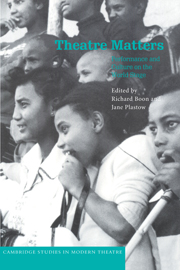Book contents
- Frontmatter
- Contents
- Notes on contributors
- Foreword: A letter from Kingston
- Preface
- Acknowledgements
- 1 Introduction
- 2 ‘The Revolution as Muse’: drama as surreptitious insurrection in a post-colonial, military state
- 3 Making theatre for a change: two plays of the Eritrean liberation struggle
- 4 Race matters in South African theatre
- 5 Dreams of violence: moving beyond colonialism in Canadian and Caribbean drama
- 6 The French-speaking Caribbean: journeying from the native land
- 7 ‘Binglishing’ the stage: a generation of Asian theatre in England
- 8 Popular theatre for the building of social awareness: the Indian experience
- 9 The promise of performance: True Love/Real Love
- 10 Making America or making revolution: the theatre of Ricardo Halac in Argentina
- Index
3 - Making theatre for a change: two plays of the Eritrean liberation struggle
Published online by Cambridge University Press: 25 October 2009
- Frontmatter
- Contents
- Notes on contributors
- Foreword: A letter from Kingston
- Preface
- Acknowledgements
- 1 Introduction
- 2 ‘The Revolution as Muse’: drama as surreptitious insurrection in a post-colonial, military state
- 3 Making theatre for a change: two plays of the Eritrean liberation struggle
- 4 Race matters in South African theatre
- 5 Dreams of violence: moving beyond colonialism in Canadian and Caribbean drama
- 6 The French-speaking Caribbean: journeying from the native land
- 7 ‘Binglishing’ the stage: a generation of Asian theatre in England
- 8 Popular theatre for the building of social awareness: the Indian experience
- 9 The promise of performance: True Love/Real Love
- 10 Making America or making revolution: the theatre of Ricardo Halac in Argentina
- Index
Summary
The Eritrean struggle for freedom from Ethiopian colonial rule lasted for thirty years, from 1961 to 1991. It was a war that led to exile for more than half a million of the country's three-and-a-half million population and internal displacement for many more. More than 65,000 Eritrean fighters as well as an unknown number of civilians died in a conflict which pitted guerrilla forces against black Africa's largest army, made up of 300, 000 troops. Eritrea received almost no external help, whilst Ethiopia was supported initially by the United States and later, from the mid-1970s, hugely by the USSR. In this genocidal war no Eritrean was safe. For, as well as conducting a formal military campaign, Ethiopia sought to cut off the guerrillas' supply and information lines by napalming villages and terrorising and torturing urban-dwellers; most horrifically of all, Ethiopia even tried to breed out Eritrean identity through encouraging the impregnation of Eritrean women by Ethiopians, either through marriage or rape.
The David-and-Goliath nature of the struggle makes the story of this liberation war extraordinary, but what makes it unique is that the Eritrean People's Liberation Front (EPLF) was simultaneously conducting wars against colonialism and against the feudal ideologies which had dominated Eritrea for thousands of years. This is the story of two plays which were produced by EPLF Cultural Troupes in support of those dual aims, and the story of how theatre was used as part of the armoury of resistance by the liberation forces.
- Type
- Chapter
- Information
- Theatre MattersPerformance and Culture on the World Stage, pp. 36 - 54Publisher: Cambridge University PressPrint publication year: 1998
- 4
- Cited by



